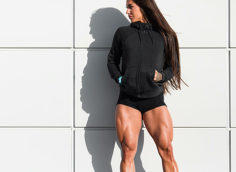The Forgotten Element
Overhead pressing proficiency is the lost element in most bodybuilding and strength training programs. Far too much time and effort is instead spent on training the bench press, particularly for athletes. Those who omit overhead pressing from their training plan can experience severe consequences!
Training overhead pressing strength offers many advantages:
- It's an excellent form of overload to build shoulders, traps, and triceps.
- One of the best ways to get a great bench press is to train overhead pressing strength. Because of various inhibition mechanisms, your bench press progress is often stalled until you spend time on the overhead press.
- Training overhead pressing strength can improve your long-term shoulder health. Training only the bench press pathway is often the cause of many shoulder problems because the subscapularis muscle becomes shortened and puts pressure on the shoulder joint.
- Overhead pressing is a great conditioner for the lower back and other core muscles. It's also a great diagnostic tool for the strength coach. For example, a weak lower back becomes obvious during the performance of the overhead press.
- Most shoulder pain in the weight trainee can, without a doubt, be traced to a lack of overhead pressing work. My colleague Bill Starr pinpointed the same reason many moons ago. Until the mid-seventies, overhead pressing measures were popular amongst iron game practitioners. Once the press was dropped from Olympic competition, it fell out of favor.
Of course, one could argue that other predictors such as external rotator strength pinpoint the cause. Yes, but overhead pressing strength is a better predictor. Nick Liatsos, Boston based physical therapist, has the same opinion. He treats plenty of strength athletes and has made the same observation. He's also of the opinion that one should be able to press behind the neck to demonstrate healthy shoulder function, and that the behind-the-neck press to bench press strength ratio is a predictor of shoulder health.
When we do upper extremity structural balance testing as outlined in the Level 1 PICP practical course, we can identify a strong correlation between shoulder pain and lack of overhead strength. There are two ratios of interest that can point that out:
- The ratio between seated dumbbell overhead presses and the bench press. It should be that the weight done for 8 reps on each dumbbell represents 29% of the close-grip bench press measure. In other words, a man able to close-grip bench about 220 pounds for a single would use a pair of 65's for 8 reps in the seated dumbbell overhead presses.
- The ratio between the behind-the-neck press and the bench press. The weight for a 1 RM behind-the-neck press from a seated position should represent 66% of the weight used for a 1 RM in the close-grip bench press. That load is lifted from a dead-stop position with the bar resting on the traps, not from a weight handed off in the lock-out position.
Technical Points
Here are some technical points to think about before we look at the routine:
- Whether you're doing front or behind-the-neck presses, make sure that your dominant leg is about 10 to 12 inches forward to the other foot. This diminishes pressure on the lower back compared to the standard feet-aligned technique. Within the first workout you'll know how effective your lower back training has been. Trainees with poor lower back strength will find it hard to stabilize the trunk during this exercise. Therefore, if you can sense that the lower back is limiting your overhead power, it's time you devote more effort to increasing the loads you can handle in lower back work.
- If you have difficulty doing front presses because of a flexibility issue, A.R.T. (Active Release Technique) will do the trick. A qualified practitioner that releases the shoulder girdle muscles and a few forearm muscles should be able to set you in the right groove in a matter of only a few treatments. To find the A.R.T. practitioner in your area, go to www.activerelease.com. Depending on the sports biomechanics background of the practitioner, he may not know exactly how to help you, but you could always give him this list of structures as a starting point:
subscapularis
serratus
subscapularis tied to serratus
infraspinatus
teres minor
teres major
latissimus dorsi
teres major tied latissimus dorsi
long head of the triceps
deep and superficial forearm flexors
pronator teres - Make sure to include some rhomboid work and external rotator work when specializing on the overhead press. Just look at Eric Cressey's article on this topic for some ideas. A great way to catch up on overhead work is to forgo the bench press and its variations for twelve weeks or so. Don't freak out. Your bench press won't sink to abysmal levels. In fact, it'll jolt to new levels once you return to doing it!
The Program: A 12-Week Cycle for Overhead Pressing Strength
Here's a way to cycle your overhead strength work. Do the given exercise paired with an antagonistic exercise of your choice. In the case of the shoulders, antagonistic work would consist of pull-ups, one-arm pull-ups, one-arm pulley pull-ups, etc. Once you've done the exercise for four workouts, move to the next phase.
Workouts 1 to 4
One-Arm Braced Overhead Dumbbell Press

Start off with 5 x 6-8 reps on a 40X0 tempo. (This means you'd lower the weight in four seconds and immediately change direction and lift explosively for the concentric portion.) Rest 90 seconds before doing the antagonistic exercise. Rest another 90 seconds before returning to it.
Make sure to take an additional 10 seconds between arms to ensure quality work. You can apply the 5% solution to this set and rep scheme. Just refer to my previous article on this topic.
Stand and hold a dumbbell in the non-dominant hand. Use the other hand to hold onto a power rack post. If you're holding the dumbbell in the left hand, the right leg is forward in a semi-lunge position, and the right arm is extended at shoulder level holding on to the power rack post. This exercise allows for a greater range of motion in the pressing range than in the two hand dumbbell press as the scapulae can move more freely.
The key here is to keep the hand in a neutral grip (semi-supinated), not a pronated grip (palms-down). By training only one side at a time, you'll allow the scapulae to move over a greater distance.
Make an extra effort to bring the biceps as close to your head as possible when you're nearly completing the concentric (lifting) range. I said biceps-to-head, not head-to-biceps. Again, the extra range comes in handy to restore shoulder health.
Always start the series with your non-dominant arm and match the reps with the dominant arm. Don't do more reps on the dominant arm as it'll accentuate the discrepancy.
Do not wear a belt, and make sure you keep the legs out of it! Once your legs are in the starting position, they don't move until the set is over. Again, if you're structurally balanced, you should be able to do 8 reps at a weight that's about 29% of your best single in the bench press.
Workouts 5 to 8
Seated 80 Degree Barbell Overhead Press

I suggest you do wave-like loading on this one: 5, 3, 2, 5, 3, 2 on a 31X0 tempo. Rest 2 minutes before doing the antagonistic exercise. Rest another 2 minutes before returning to it.
Start the exercise from the bottom position. You want to unrack it from pins set up for the front squat and sit down on the 80 degree bench. Then, lift up your feet and lock them up against the foot pad so that your lower back is pressed firmly against the seat pad. Again, don't wear a belt!
Make sure that the arms are in line with the ears when you reach the end of the concentric range. This will ensure optimal movement of the shoulder girdle and promote shoulder longevity.
Workouts 9 to 12
Seated Press Behind Neck with Chains

Do 6 sets for this exercise: 3 x 5 followed by 3 x 3. Rest 2 minutes before doing the antagonistic exercise; rest another 2 minutes before returning to it. A 30X0 tempo is recommended. Because of the chains, the concentric range may take 2-3 seconds, but concentrate on moving the load as rapidly as possible. Intent is the key.
Start the exercise from the bottom position. You want to unrack it from pins set up for the back squat and sit down on a regular flat bench. Don't use lower back support; you'll be fine. No belt!
Make sure that the hands are as close as possible during the initial set-up so that the range of motion is maximal.
Workouts 13 to 16
Standing Barbell Overhead Press
Do 11 sets for this exercise: 8 x 1 followed by 3 x 3-5, resting 2 minutes before doing the antagonistic exercise and another 2 minutes before returning to it. A 20X0 tempo is recommended.
When you grip the bar, make sure your index fingers are just outside the medial deltoids in the start position. This again will maximize the efficiency of the exercise.
Pick a weight where you can complete all 8 singles, then drop the weight 15% and do 3 sets of 3-5 reps. When you can complete all 8 singles, increase the weight 5 pounds in the next workout for both the singles and the multiple rep sets. This is brutal, yet very rewarding work.
Make sure that you're overhead pressing, not push pressing. Keep the legs out of it, and again, don't wear a lifting belt! Since you won't be wearing a belt, abstain from leaning back excessively and turning it into a standing incline press.
Because the law of repeated efforts is put into play, you can expect major gains in strength during this last phase. And because all these singles potentiate your nervous system, the functional hypertrophy work done at the end will pay off even more.
Wrap-Up
This cycle is great for anyone with more than two years of experience in the weightroom. It'll do wonders to develop impressive and powerful shoulders and contribute to overall superior strength!





